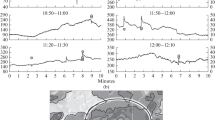Abstract
Two detection methods of hail embryons in a cloud are discussed in the paper: combined passive/active and purely active sensing of a convective cloud from board of air or space carrier. The first method makes it possible to determine the spectral dependence of absorption coefficient by oversized drops in convective cloud in the millimeter (MM) and submillimeter (SbMM) wavebands. With this purpose a highly sensitive 16-channel Dicke radiometer is used. In the second method a multiwave (12 wavelength) active radar is used to determine the spectral dependence of backscatter coefficient in the same wavebands. Variation of these spectral characteristics in time makes possible the detection of physical processes taking place in a cloud, such as drops drowth and evaporation, as well as transition of oversized drops into the overcooled state. The instant of water/ice phase transition in oversized drops is determined in both methods by means of active radar in SbMM waveband (in the transparency “window” of ice and atmosphere, 0.64 mm). Corresponding hardware, antennas, and wavelengths are considered for active/passive and purely active sensind of clouds. The effect of antenna beamwidth in SbMM on anomalous backscatter is discussed.
Similar content being viewed by others
References
Ajvazyan H.M. Millimeter and Submillimeter Wave Propagation in Clouds. Handbook. Leningrad. Hydrometeoizdat, 1991, 480pp.
Ajvazyan H.M. Radar Measurements Application in Study of Hail Formation Processes in Clouds. Izvestia Ac.Sci.USSR. Ser. “Physics of Atmosphere and Ocean”, 1991, v.27, no. 3, pp.304–316.
Ajvazyan H.M. Detection of Hail Formation Process: Liquid Drops Transition Into Ice in Clouds, by Radar Reflection of Submillimeter Waves. Doklady Armenian Ac.Sci., 1988, v.84 no. 4, pp. 166–169.
Ajvazyan H.M. Abnormal Radar Backscattering of Submillimeter Waves From Cloud Ice Particles. Int.Journ. of IR and MM Waves, 1991, v.12, no.8, pp.919–944.
Ajvazyan H.M. Small-Angle Reflection Effect on the Extinction, Scattering, and Absorption of Abnormal Radar Emission by a Cloud and Atmosphere. Preprint IRPhE, Armenian Ac.Sci., Ashtarak, 1991, no.3, 39 pp.
Ajvazyan H.M. Extinction, Scattering and Absorption of Anomalous Radar-Reflected Emission in a Cloud and Atmosphere. Int. Journ. of IR and MM Waves, 1991, v.12,no.8, pp.945–978.
Stepanenko V.D., Schukin G.G., Bobyliov L.P., Matrossov S.Yu. Thermal Radar in Metheorology. Leningrad.Hydrometeoizdat, 1987, 283pp.
Ajvazyan H.H., Ajvazyan H.M., Goulyan A.G., Martirossyan R.M. Satellite Early Detection System for Hail Formation Process in Clouds. USSR Conference “Utilization of Satellite Information in Study of Ocean and Atmosphere'. April 1989, Zvenigorod. Abstracts of Papers, Moscow, 1989, p.82.
Ajvazyan H.H., Ajvazyan H.M., Goulyan A.G. andMartirossyan R.M. Radar Equipment and Method of Hail Detection in Clouds. Proceedings of USSR Seminar “Active Probing of Hail Processes and Perspectives of Hail Reagents Improvement for active Probing Practice.” Nalchick, Oct. 16–21, 1989, Moscow, Hydrometheoizdat, 1991, pp. 260–267.
Andreev G.A., Zhevakin S.A., Sokolov A.V. Millimeter and Submillimeter Wave Propagation in the Earth's Atmosphere and Possible Applications Fields. Proc. 12th USSR Conf. on Wave Propagation. Tomsk, 1978. Moscow “Nauka”, pt. 2,pp. 62–65.
Bollander D.A., McMillan R.U., Gallager J.J. Effect of Atmosphere on Propagation of Near-Millimeter Waves, Proc.IEEE, 1975,v.63, no 1,pp.54–67.
Victorova A.A., Zhevakin S.A., Microwave Absorption in Air by the Vapour Dimers, Doklady Ac.Sci. USSR, 1966, v.171, no.6, pp. 1061–1064.
Ippolito L.D. The Effect of Radio Waves Propagation Conditions in Atmosphere on the Space Communication Systems. Proc. IEEE, 1981, v.69, no.6, pp.29–58.
Ulaby I.T., Fung A. andMoore R. Microwave Remote Sensing: Active and Passive. In 2 vol., Addisso-Weslay, New York, 1981.
Zhevakin S.A., Naumov A.P. Sentimeter, Millimeter, and Submillimeter Wave propagation in the Earth Atmosphere. Izvestia Vuzov. “Radiophysics”, 1967, v.10,no.9–10, pp. 1213–1243.
Feldstein A.L., Yavitch L.R., Smirnov V.P. Handbook on Elements of Waveguide Technology. Moscow, Sov. Radio, 1967, 652 pp.
Doviak R.J., Zrnic D.S., Doppler Radar and Weather Observation. N.Y., Academic Press, 1984, 512 pp.
Author information
Authors and Affiliations
Additional information
Finally the authors would like to acknowledge the helpful discussions and assistance of Dr. K.E.Karapetyan in calculation of the antenna E characteristics.
Rights and permissions
About this article
Cite this article
Ajvazyan, H.M., Ajvazyan, H.H. Hail embryons detection in clouds using passive and active radars in millimeter and submillimeter wave bands. Int J Infrared Milli Waves 14, 1155–1174 (1993). https://doi.org/10.1007/BF02084590
Received:
Issue Date:
DOI: https://doi.org/10.1007/BF02084590




